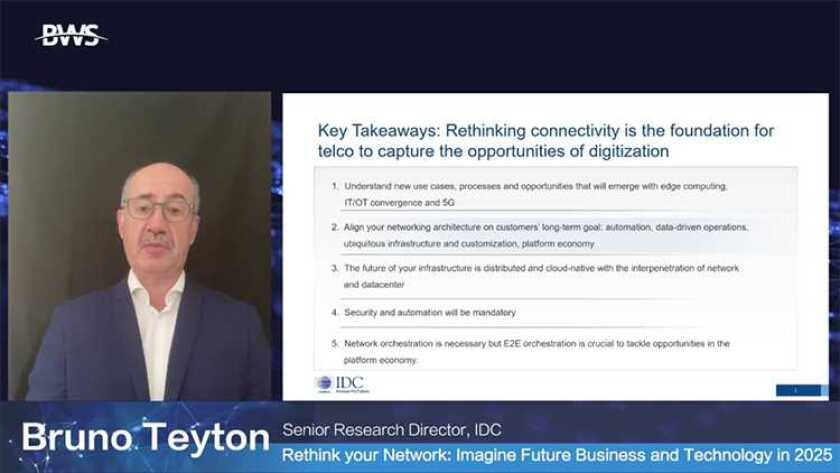It’s not very far away, but the industry will change profoundly in the few years running up to 2025.
Bruno Teyton, senior research director at IDC for telecommunications and networking, notes that the number of devices is growing at 4.8% a year, and that means there will be 55.7 billion of them by 2025 – and a significant 74%, nearly three quarters, will be internet of things (IoT) devices.
This huge increase in connectivity “will control production lines, robots and vehicles”, said Teyton, speaking at Huawei Better World Summit NetX 2025 & X-Tech. “None of these changes can be achieved without good connectivity.”
And good connectivity means re-designed connectivity. Teyton said that in the few short years to 2025 “we’ll see a shift to the edge”. More than 50% of new infrastructure in 2025 will be in edge locations, he said, compared with under 10% today.
“By 2023 70% of enterprises will run some data processing at the IoT edge.” Connected devices will be pervasive, he added, affecting people, things and processes – with processes including connected factories, smart grids, remote healthcare, smart buildings, omnichannel retail and smart transport.
He focuses on mining, where telemetry data would be used for maintenance and safety.
This is where moving work to the edge makes sense. With so much data, the cost of transmitting it for central processing would be prohibitive, he explained.
There will be legal issues that companies have to take into account for security and compliance: there might be restrictions on where data will reside, he points out. Storing data at the edge will help to solve that: “The edge will improve the decision-making process.”
We’ll also see a move from capex to opex, Teyton pointed out in his talk at the Better World Summit, with access to more cloud-native solutions.
“Software-defined everything will be the key to becoming more agile and location independent,” he said.
Artificial intelligence (AI) and automation will be crucial. That’s happening already: “2025 will see a 100% increase in productivity for enterprises using AI and automation,” said Teyton. Companies will benefit from shorter reaction times, more agility and more success in innovation – a 25% increase in the rate of new product introduction, he said. “Telecoms operators will need to help enterprise customers achieve this.”
Teyton introduced the idea of the three Hs – hyperscale, hyperspeed and hyperconnectivity – which will define the future business and technology environment. “Enterprises will build digital innovation factories and telecoms operators can help enterprises scale and deliver hyperconnectivity – but operators will also need to rethink connectivity,” he said.
“We are getting to a period when we have to move work from network node to network node to provide the best experience to the end user.”
Operators will need to manage “tens of data centres, hundreds of central offices, thousands of telco edges and millions of customer devices”, he pointed out. “This is really a crucial challenge. These are massive numbers.” Networks will carry “zettabytes of data”, and this is “a growing challenge”, he warned.
The development of mobile edge computing (MEC) will bring “opportunities for alliances between the hyperscalers and telecoms operators, becoming a continuum”, and also “between the edge and the cloud”.
Teyton pointed out that “5G is not necessary for MEC, but MEC will be part of 5G”, and the use of MEC and network slicing “will bring new revenue streams” to the industry. “There are many exciting opportunities.”
Half of mobile operators with 5G will use network slicing “to offer secure and segmented 5G”, he said. This means 5G will offer an alternative to enterprise WANs and existing wireline VPNs, leading to “improved productivity”. Teyton added: “The improvement will rely on distributed and cloud-native networks.”
And there will be other improvements at the same time, he added, including customer care, billing, revenue assurance, fraud management and other areas.
Telecoms operators “will need an end-to-end orchestration platform, and the orchestration must be flexible, to help partners become flexible”.
He concluded by offering five key takeaways:
Understand new use cases, processes and opportunities that will emerge with edge computing, IT/OT convergence and 5G;
Align your networking architecture on customers’ long-term goal: automation, data-driven operations, ubiquitous infrastructure and customisation, platform economy;
The future of your infrastructure is distributed and cloud-native with the interpenetration of network and data centre;
Security and automation will be mandatory; and
Network orchestration is necessary but end-to-end orchestration is crucial to tackle opportunities in the platform economy.
Sponsored entry





